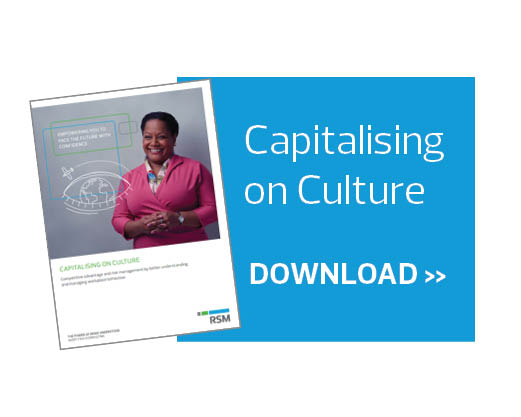Over recent years we have strived to create resilient, high performing teams, fully engaged, agile, workforces and above-the-line actions to collaboratively achieve a future vision.
With all attention focused on constructing these blocks of success, the condition of the foundations on which they are built has been brushed aside leading to a breakdown in processes, controls, governance and ultimately trust. At its core, this has been attributed to workplace culture.
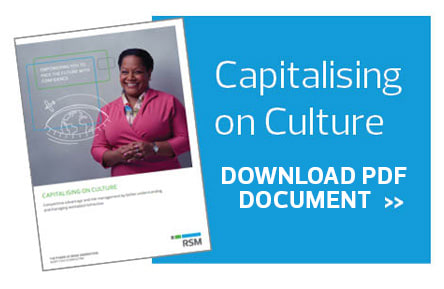 Workplace culture, much like the personality of an individual, is a combination of the values, attitudes and behaviours involved in the delivery of business operations, and engagement with stakeholders. It really is “the way we do things around here” and is often the unrecognised key contributor when dealing with a crisis or failure in governance, controls and performance.
Workplace culture, much like the personality of an individual, is a combination of the values, attitudes and behaviours involved in the delivery of business operations, and engagement with stakeholders. It really is “the way we do things around here” and is often the unrecognised key contributor when dealing with a crisis or failure in governance, controls and performance.
 In 2018, John Price, Commissioner of the Australian Securities and Investments Commission (ASIC), spoke about how ASIC believed that workplace culture is at the heart of how an organisation and its staff think and behave. With society coming to expect much more from companies than short-term shareholder returns, the concept of corporate social licence to operate now extends a company’s legitimacy in our society. This is becoming even more marked as shareholder activism becomes ever more prominent – requiring specific conduct and demanding agreed standards of behaviour.
In 2018, John Price, Commissioner of the Australian Securities and Investments Commission (ASIC), spoke about how ASIC believed that workplace culture is at the heart of how an organisation and its staff think and behave. With society coming to expect much more from companies than short-term shareholder returns, the concept of corporate social licence to operate now extends a company’s legitimacy in our society. This is becoming even more marked as shareholder activism becomes ever more prominent – requiring specific conduct and demanding agreed standards of behaviour.
Consistent with the current published intentions of other regulators, such as the Australian Prudential Regulation Authority (APRA), ASIC’s role has not been to dictate a company’s culture – indeed how can a regulator set culture and why should it? It is the responsibility of an organisation’s leaders to understand, define, measure, monitor and leverage culture to maximise its value for all stakeholders.
The final report from the Royal Commission into Misconduct in the Banking, Superannuation and Financial Services (the Royal Commission) further emphasised this by recommending that:
Regulators should:
|
Entities should as often as reasonably possible, take proper steps to:
|
What are the guiding principles of workplace culture?
When assessing culture, it is important to consider that organisations generally have the power to control what they do internally, but may only be able to influence external teams or demonstrate their concern for third parties or the broader industry.
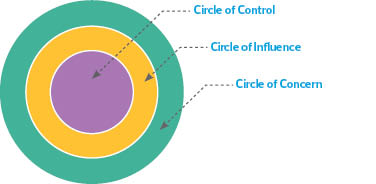 Using Steven Covey’s Circles of Influence tool, as shown below, assists in determining the impact that strong initiatives can have throughout the various levels of influence and can identify where an organisation can focus its efforts to achieve a desired outcome.
Using Steven Covey’s Circles of Influence tool, as shown below, assists in determining the impact that strong initiatives can have throughout the various levels of influence and can identify where an organisation can focus its efforts to achieve a desired outcome.
While some models of organisational effectiveness go in and out of fashion, one that has persisted is the McKinsey 7-S framework. Developed in the early 1980s by Tom Peters and Robert Waterman, two consultants working at the McKinsey & Company consulting firm, the framework remains one of the benchmark tools for work on organisations and culture.
The basic premise of the model is that there are seven internal aspects of an organisation that need to be aligned if it is to be successful:
|
|
By building on this thinking, embedding world class cultural assessment tools and then integrating the model with our knowledge and experience in risk, internal audit and consulting, RSM has developed a unique approach to help harness the potential within an organisation.
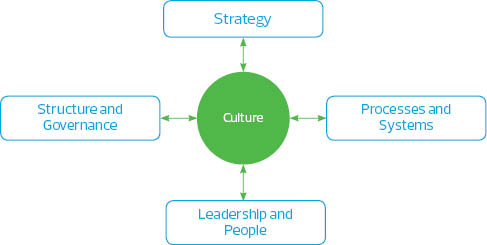
Our approach both effectively defines culture and further develops a bespoke approach which assesses critical areas of a business (often traditionally assessed only for compliance) with the impact these have on the culture of an organisation, and vice versa.
Our RSM methodology and approach to workplace culture
Boards and regulators are more than ever looking to find proactive ways to manage behaviours, measure people risk and govern it accordingly. RSM has developed, tested and proven, a powerful methodology to assist in identifying and assessing culture. Incorporating a rigorous scoping exercise to ensure we meet your requirements, this methodology is based around three core areas: 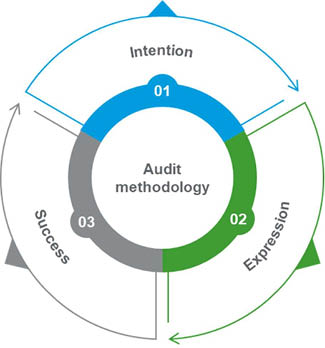
1. Intention – an assessment of the kind of culture the organisation’s leaders want and believe to be in place
2. Expression – an evaluation of how effectively and consistently the organisation communicates and embeds its desired culture at all levels
3. Success – an assessment of the extent to which the organisation has achieved its desired culture
To assess the current culture, we always recommend to start at the top with a Board and senior management workshop – this is where the tone that underlies behaviours is set.
Questions which would typically be explored include the following:
- What do you think culture means, why is it important?
- What is your perception of your organisation’s culture?
- Does this align with the organisation’s vision and values?
- Do you think your staff are aware of the organisations culture?
- How could you further enhance culture?
RSM has also developed an extensive questionnaire enabling customisable and targeted questions. These are asked to a selection of staff and management to assist in determining the underlying culture of the organisation. This approach enables a comparison, and analysis, to be made which can assess key cultural drivers such as the:
- Rigor of Board and Executive Committee governance of non-financial risks
- Nature of accountability, potentially reinforced by remuneration practices
- Authority and capability of the operational risk management and compliance functions
- Appetite to empower, challenge and strive for best practice in risk identification and remediation
Where appropriate, we deploy leading culture assessment diagnostic tools to provide an opportunity to engage a wide variety of staff and capture, in clear and objective terms, the key behaviours that underpin culture. Correctly deployed, they can highlight key gaps, areas of risk, as well as the aspirations and concerns staff often have when lived behaviours are inconsistent with stated values. Specific programs to refine values and reinforce appropriate behaviours will typically emerge from this phase of work.
Culture can be the difference between a business that lasts and one that crumples under pressure.
IIA Organisational Culture - Evolving approaches to embedding and assurance
Assisting in workplace change and transformation
The assistance we provide to organisations in respect to culture and behaviours extends beyond the identification of theoretical possibilities. Our RSM Change and Transformation specialists identify opportunities and initiatives and guide you through the planning and implementation. We also support in the assessment and monitor achievement of specific change goals and objectives.
 At RSM, we recognise that transformation is much more than soft, safe incremental change – it is a marked (and sometimes radical) change in form, nature, or appearance. A dynamic and changing world presents opportunities and a requirement for organisations to embrace and embed change. On occasions it is necessary not just to change but to transform the way an organisation looks at its market, serves its customers and outplays its competitors.
At RSM, we recognise that transformation is much more than soft, safe incremental change – it is a marked (and sometimes radical) change in form, nature, or appearance. A dynamic and changing world presents opportunities and a requirement for organisations to embrace and embed change. On occasions it is necessary not just to change but to transform the way an organisation looks at its market, serves its customers and outplays its competitors.
Transformation Programs (TP) emerge when it is recognised that new ways, not minor improvements to existing practices, are necessary to exploit an opportunity or address a threat. Well conceived, the TPs are often departmental or organisational wide and can include:
- Reframing and reworking the way an organisation views its market, products and services
- Aligning planning, performance measurement and resources to achieve new strategic objectives
- Assessing the cost benefits of changes in business processes or deployment of technological systems
- Streamlining of business units or assets
Transformation programs are hard work and if well executed can deliver many benefits to an organisation. Benefits should be measured in tangible ways with clear verification of the outcomes achieved. Measures of success could include:
- Successful deployment of new practices to enhance products and services, boosting market share and overall financial performance
- Reduction or elimination of high-risk or inefficient activities
- Clear quantification of prospective future-state models and enabling a cost benefit analysis of available options
- A tangible shift in culture and lived behaviours to support and embrace change to ensure organisational readiness for future challenges
Our methodology to assist in identifying, and assessing, options within an organisation is built around four core pillars and workflows:
- Service Delivery and Alignment - Performance of the services, for example time to process a transaction, consistency of advice and equality of access to specialist services
- Innovation, Risk and Quality - This refers to the quality of the services as perceived by service users (stakeholders) and the value that is added by alternative operating models
- Value and Cost - Covering benefits which reduce the cost of service in terms of productivity savings, efficiency savings, cash releasing, cost avoidance or releasing productive time
- Capability and People - This covers an assessment of whether the critical areas have the right people and processes to support the operations
RSM is uniquely placed in the Australian Accounting Profession as a national partnership with over 100 Partners and Principals and over 1,200 staff operating out of 30 offices throughout Australia.
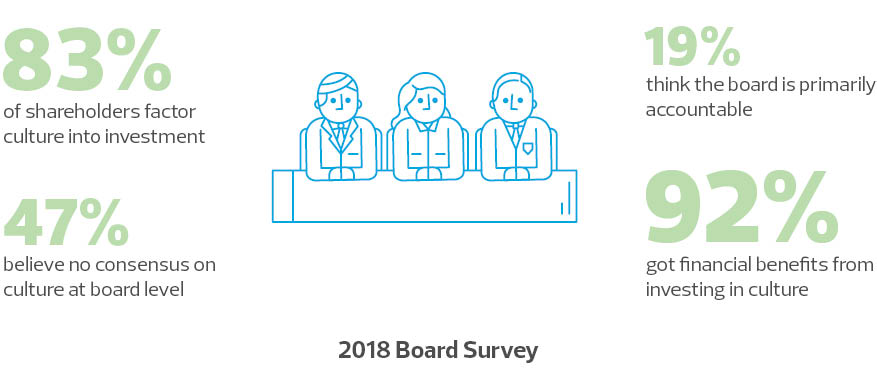
Throughout our history, we have strived to deliver highly personalised service to each and every client – a principle which pioneered our success over 95 years ago. RSM is the 6th largest global audit, tax and consulting network including the world’s top 40 major business centres - to help guide clients through business challenges, both locally and seamlessly across borders.
How can RSM help?
With a team of in-house advisers who are trained and experienced in delivering cultural reviews , RSM is committed to providing value generating services to provide a better understanding of the key drivers, practical and implementable opportunities to be capitalised on.
For more information, please contact your local RSM adviser here.


